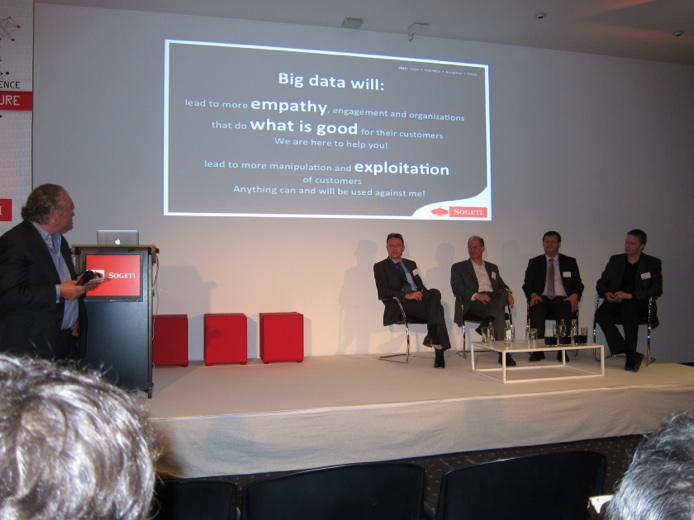Sogeti Belux 2012 Conference in Brussels

June 20 marked this year’s Sogeti Belux Conference Day. The picture above shows Yves de Beauregard (CEO Sogeti Belux). Attendees could choose among 28 presentations in the afternoon. Alliance partners at this event were IBM and Microsoft. It was a nice event to learn about the latest developments from software vendors/Sogeti consultants, and meet a lot of Sogeti’s customers for informal conversations. UGent was represented by Prof. Jean-Jacques De Clercq and myself (Prof. Dr. Dirk Van den Poel). The report below is a mixture of our reports attending different parallel sessions.
Wednesday 20 June 2012

There’s also an exhibit floor to discuss solutions in more detail (see picture below). During the afternoon, it was often a tough choice with 4 or 5 parallel sessions.
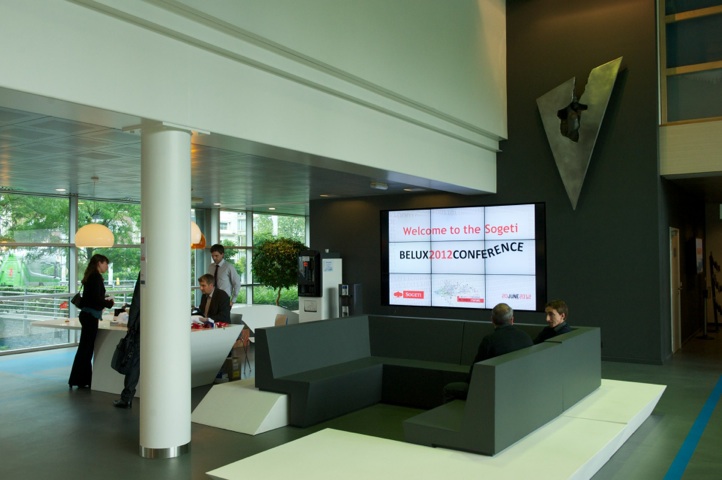
I decided to attend the following session: “Deploying a Flexible Workstyle by using Windows 8 Entreprise” by Wouter Van Ranst (below - left), Microsoft & Johan Vermeulen, Sogeti (below - right). They focused on the innovations in the new version of the OS.
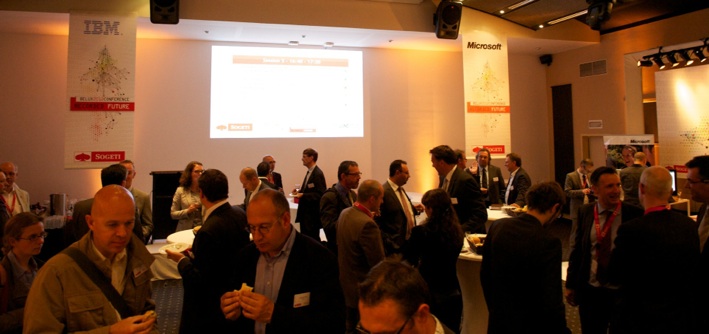
Prof. Jean-Jacques De Clercq attended the talk “Tailoring TMap® Next: Going from traditional V-model to iterative testing?” by Jo Vanpaeschen (Sogeti). Because it was used at KB Insurance Services he had to implement an Agile methodology in a waterfall environment. By cutting the waterfall project into separate applications he was able to use one-month iterations + two-weekly patches. Once the software was good enough it was tested and when not OK iterated. He used also the well known Test Design Burndown Chart and the DONE-ness model: gathering requirements, building phase, acceptance testing, defect resolution and finally change control. The daily huddles on the progress together with the issue status gave him an idea of the team’s progression. He concluded that when mixing methodologies you can re-use the basics, but stay creative and adapt your system to the customer’s needs.
Next, I visited the session titled “Developing Applications for Windows 8” by Wouter Van Ranst, Microsoft & Filip Stappers, Sogeti. They discussed the Windows 8 “store” for Metro-style applications. Mr. Stappers showed a very nice implementation of the new style.
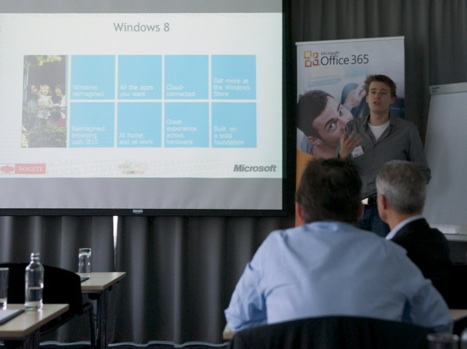
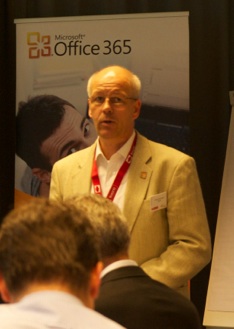
Prof. Jean-Jacques De Clercq attended the talk “Business Productivity in the Cloud with Office 365” by
Koen Van Tolhuyzen (Microsoft) & Redouan Cherkaoui (Sogeti). They talked about business productivity with Office365 in the Cloud. They offered a very revealing explanation of the features of Office365. There is indeed more than meets the eye. Your costs will go down by 70% and this offer is most appealing for smaller companies. Next year, nearly 20% of the companies will have outsourced their hardware. The main philosophy is to keep your company-sensitive material in-house and most of the Office operations in the Cloud. Office365 contains 4 important applications: Exchange (voicemail, calendar, unified messaging, backup of PST file in the cloud and not on the PC anymore, legal hold, retention policies etc), Sharepoint (share docs and access off-line with Groove, manage own websites, doc-level permissions), Office (pay per user license and use it on different machines, people leaving the organization automatically loose their license, also free simplified version for students as an alternative for Google docs), LYNC (chat and online meetings, live federation, desktop sharing). Good practice is to keep heavy load functions in-house like LOB, BI and fast search and move the more lightweight applications into the cloud. Sogeti can offer his customers the CDC (Cloud Delivery Center) to assess, design, pilot, migrate and follow-up your applications in the cloud.
Next, I attended Freddy Maetens (CIO of Mensura)‘s talk on “Start small, think Big” – creating customer value with Agile BI. They showed a convincing BI case study using timeXtender and Targit.
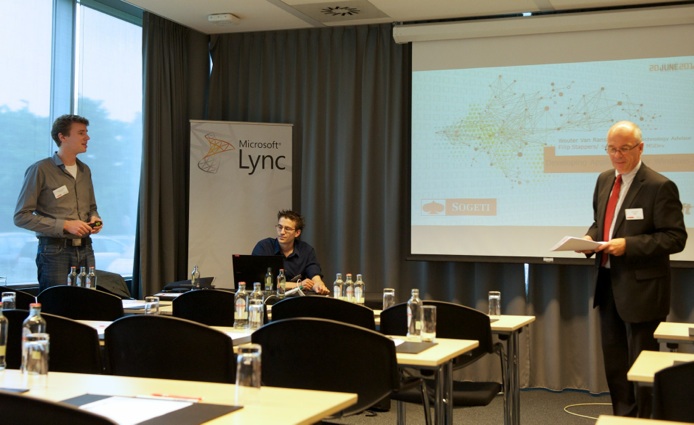
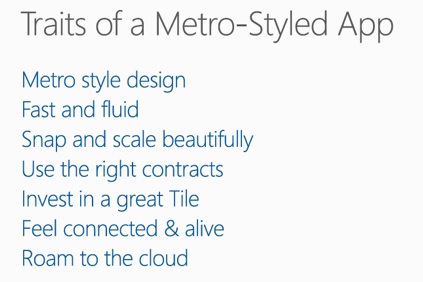
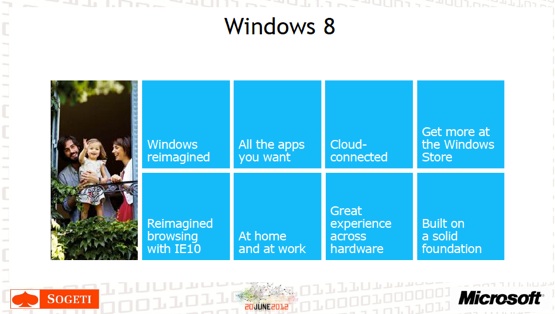
Next, I attended Prof. Dries Van Nieuwenhuyse (see picture below)’s talk on the topic of Systemic Performance Management. All attendees to this session also received his new book (in Dutch). He gave a very inspiring talk!
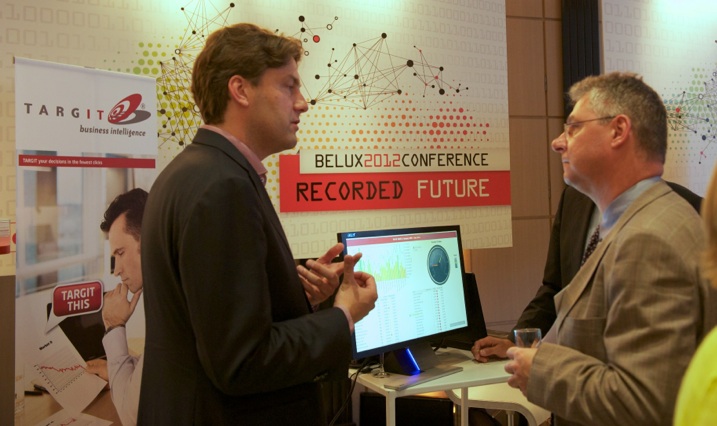
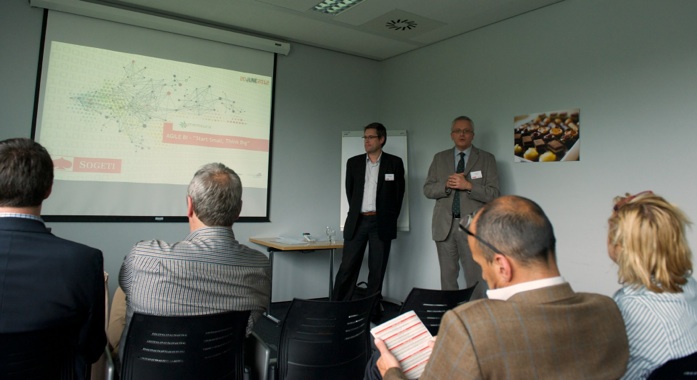
Prof. Jean-Jacques De Clercq attended the talk “Analytics justification and engine for Big Data” by Dai Clegg, (IBM) + Testimonial from Ilja Bakker (Sogeti). They talked about Analytics as a justification with Big Data engines. They mentioned several IBM use cases like Toronto Hospital for prediction of neonatal infections, TELCO for scoring data live, InsureTheBox for monitoring of 18-year old crash drivers. In all those cases they used the IBM Netezza and Infosphere Big Insights which is an improved Hadoop environment containing Infosphere streams + Insights + Netezza with a link to your existing data warehouse without any additional admin or knowledge needed. Also pervasive BI by real time analysis of streaming data. Finally Ilse Bakker presented the Sogeti Netezza Twinfin Datacenter as POC.
Next, Christian Glatschke (see picture below) presented “Gaining Critical Business Insights from Machine-generated Big Data” (Splunk). This was the first session in a list of “Big Data” presentations.
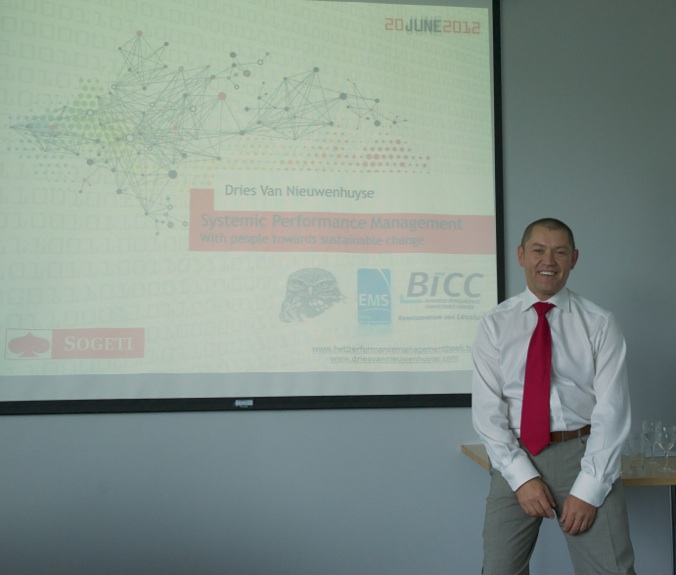
Microsoft also presented their view on Big Data: “Fast Forward with Microsoft Big Data and BI technology“ by Wesley Backelant, Microsoft & Ilja Bakker, Sogeti. Microsoft claims to be able to process petabytes of data with their Petabyte Cloud Solution consisting of Sharepoint connecting with other Big Data sites through Azure. Everybody knows that Sharepoint is very slow when you have to process lots of data and certainly in the Cloud because then Microsoft themselves advises you to go in-house for IO-intensive Sharepoint jobs. They also offer an add-on Hive connector for Microsoft Excel (Power pivot & View). The data that has been collected through the cloud will be imported by ODBC. Biggest surprise is that after a 5-year long prosecution of SUN Java Microsoft is going to start writing Javascript to implement the map-reduce framework.
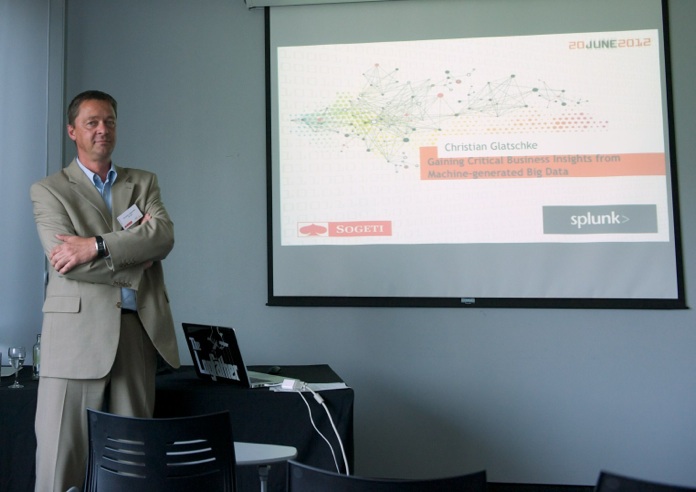
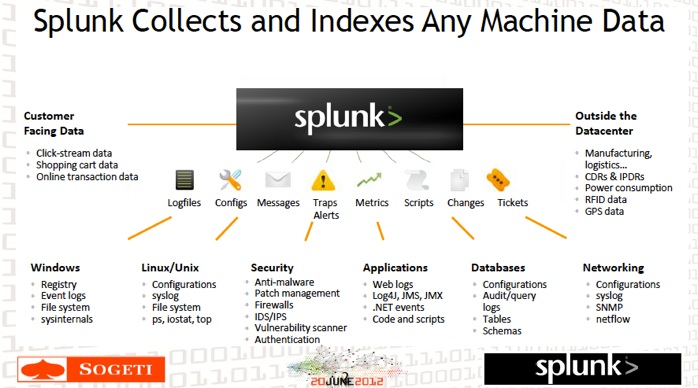
After a cocktail event, the evening session was kicked off by two hosts: Michiel Boreel and Menno van Doorn (both Sogeti Netherlands) on the “Big Data” main topic. Michiel Boreel talked about the positive side of Big Data (Data -> Information -> Knowledge -> Wisdom -> Enlightment or how we can influence things). Menno van Doorn (see picture below - left) on the other hand talked about the downsides of big data (secrets are good, big data mafia irritates privacy, why should we trust big data).
An interesting white paper is available for download from this website: vint.sogeti.com/bigdata (you will also find very interesting videos here + interesting blog posts).
The first speaker of the evening was Dirk deRoos (IBM Canada, see picture below - right). He presented IBM’s Big Insights approach using Hadoop technology. He talked about the world becoming more instrumented (30 million of RFID tags and 4,6 million of mobile systems; the internet of things) + more interconnected + added intelligence which will give an enormous boost to the availability of data. He also gave some examples of integration of relational data with Hadoop data: weather analysis, smart grid management, log analysis, geomapping, epidemic early warning etc.
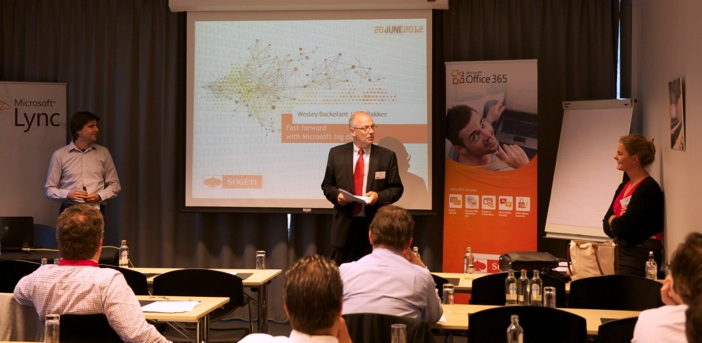
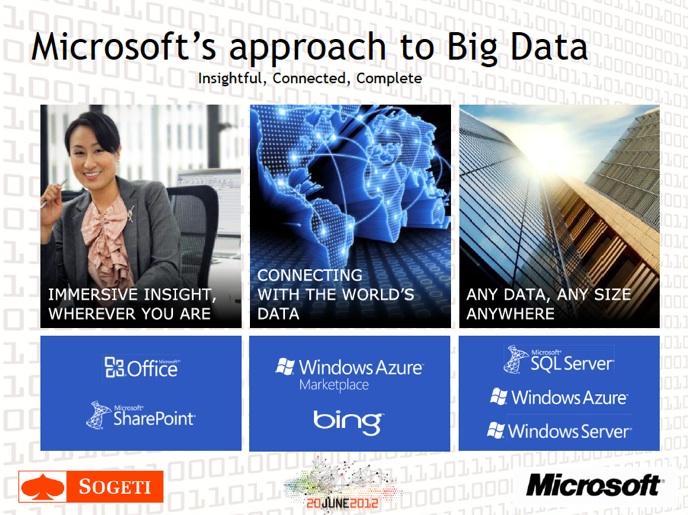
Next, yours truly (Prof. Dr. Dirk Van den Poel) talked about opportunities for Big Data in marketing applications. Of course, I could not resist mentioning our Master of Science in Marketing Analysis and Marketing Engineering programs in predictive analytics at Ghent University. Thanks to Prof. Em. Jean-Jacques De Clercq for taking the pictures below.


Next, Prof. Dr. David Weinberger (Harvard University, see picture below) entertained the 300+ attendees with his interesting views.
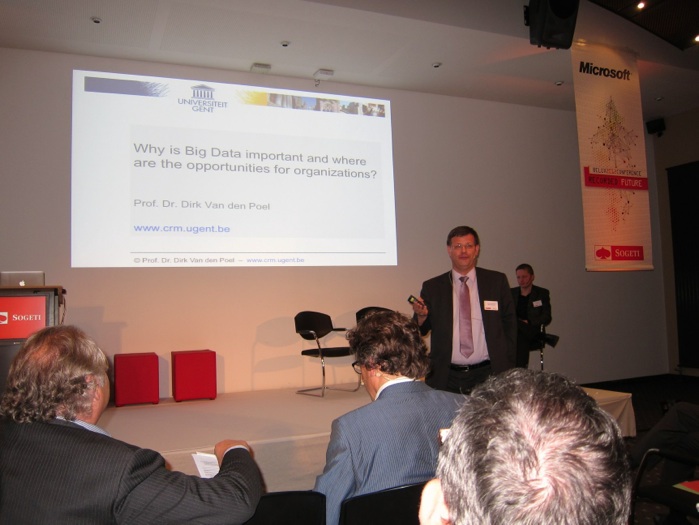
Prof. Dr. Luciano Floridi (University of Hertfordshire & University of Oxford) was the last speaker sharing his view on the big data challenge. Next, the two hosts started an interactive panel discussion.

This very interesting Sogeti day ended with an excellent walking dinner. In sum, it was a very interesting day both in terms of content, and for the networking opportunities! Congratulations to the organizers.
